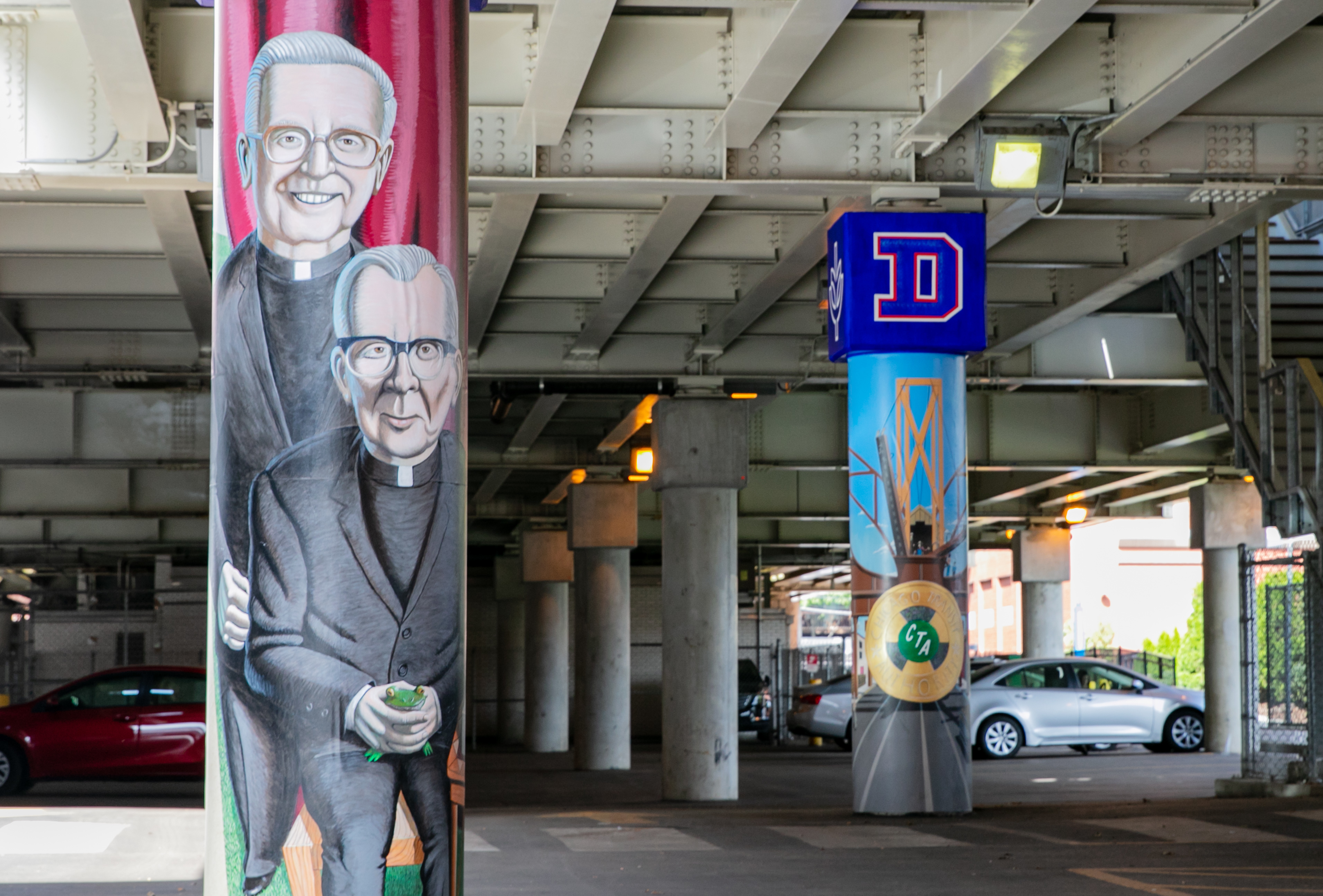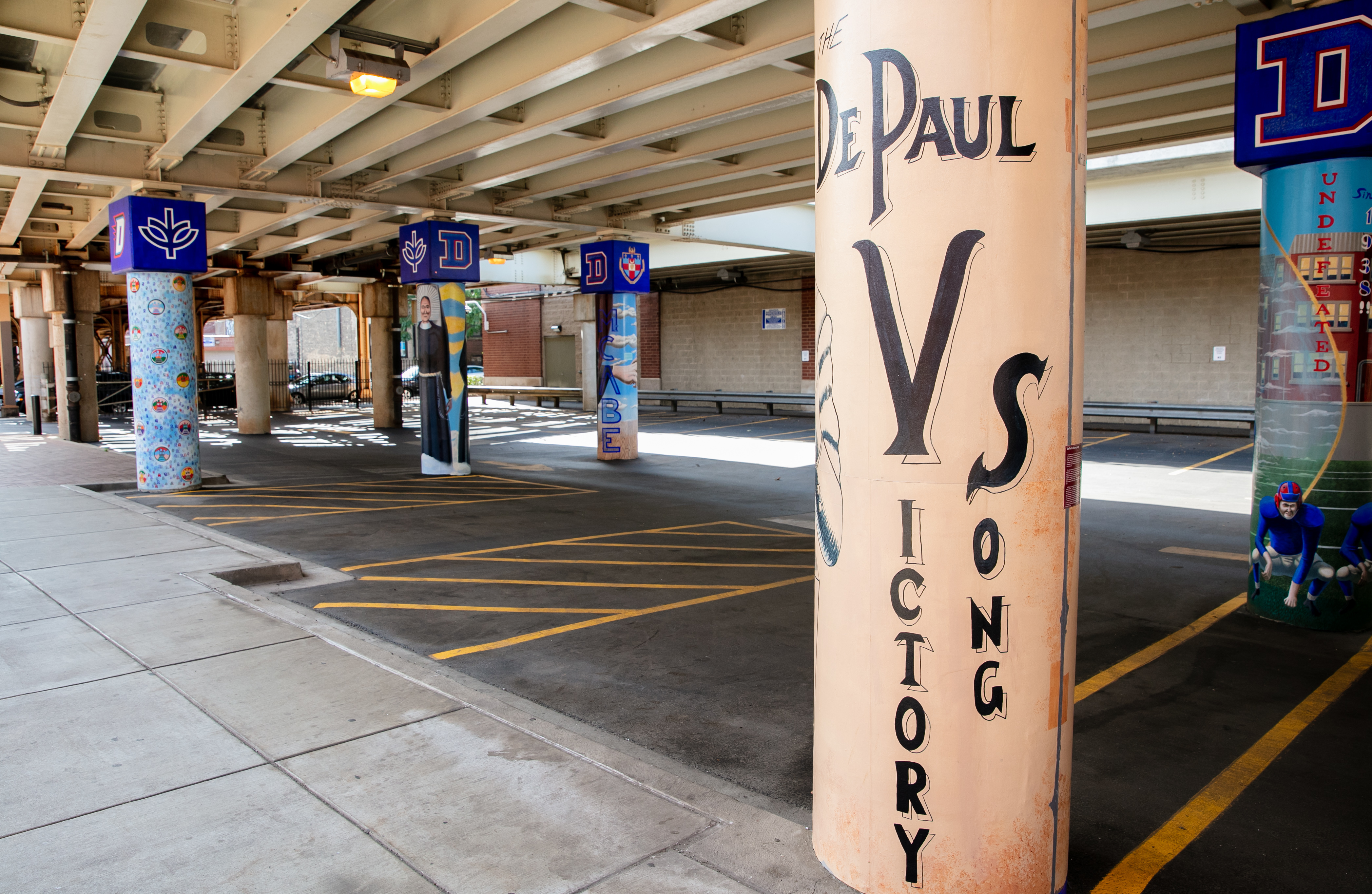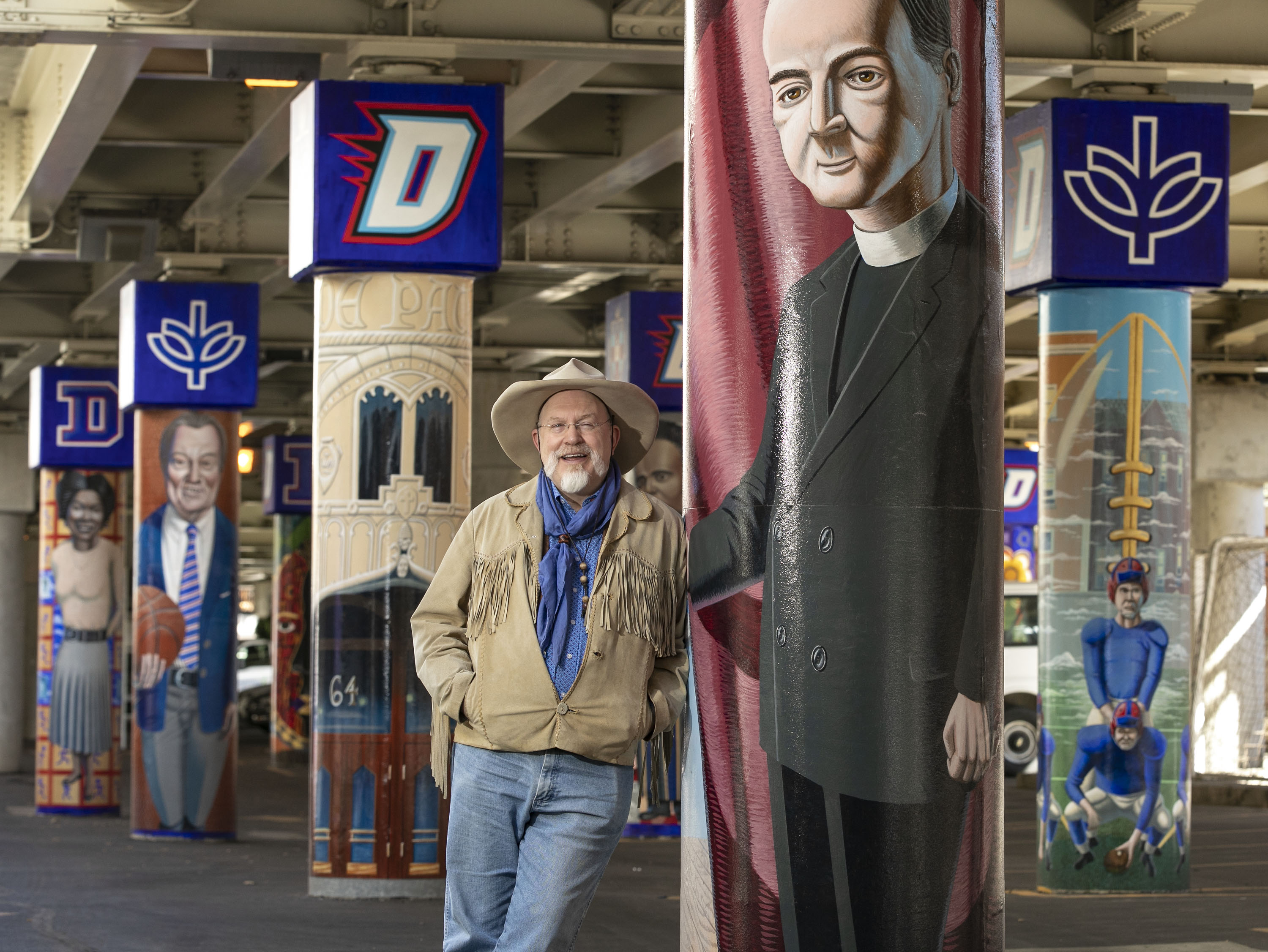
A mural honoring DePaul's relationship with the Chicago Transit Authority (CTA), which connects the university's Lincoln Park and Loop campuses together via the Red and Brown 'L' lines. The Fullerton ‘L’ stop was built in 1900, just two years after DePaul’s founding in 1898. It's one of four new murals by muralist Brother Mark Elder, C.M., which is now on display under the Fullerton 'L' stop on DePaul's Lincoln Park Campus. (DePaul University/Randall Spriggs)

A mural honoring former DePaul presidents the Rev. John R. Cortelyou, C.M. (1964-81), and the Rev. John T. Richardson, C.M. (1981-93), the university’s eighth and ninth presidents, respectively. The tenures of both presidents were times of monumental growth at the university, both in terms of the university footprint on the Lincoln Park and Loop campuses and in terms of expanded student enrollment. It's one of four new murals by muralist Brother Mark Elder, C.M., which is now on display under the Fullerton 'L' stop on DePaul's Lincoln Park Campus. (DePaul University/Randall Spriggs)

A mural honoring the 1979 men’s basketball team, which advanced to the program’s second Final Four. Led by legendary DePaul coach Ray Meyer, the 1979 squad featured future NBA players Mark Aguirre and Terry Cummings. It's one of four new murals by muralist Brother Mark Elder, C.M., which is now on display under the Fullerton 'L' stop on DePaul's Lincoln Park Campus. (DePaul University/Randall Spriggs)

A mural remembering Arthur C. Becker, the first School of Music dean, and the DePaul “Victory Song,” which was written in 1930 by Becker and faculty member J. Leo Sullivan. The "Victory Song" has been the university's official fight song since 1965. It's one of four new murals by muralist Brother Mark Elder, C.M., which is now on display under the Fullerton 'L' stop on DePaul's Lincoln Park Campus. (DePaul University/Randall Spriggs)
The four new works recognize the CTA; former DePaul presidents the Rev. John R. Cortelyou, C.M., and the Rev. John T. Richardson, C.M.; the university’s victory song; and the 1979 men’s basketball team that advanced to the Final Four.
The project, which started in 2016, now has 16 murals that wrap concrete pillars under the ‘L’ tracks. It is the vision of muralist Brother Mark Elder, C.M., a faculty member in DePaul’s Art, Media, and Design Department, who named the project “The Story of ‘The Little School Under the ‘L’” — Under the ‘L’.”
The new murals honor:
- DePaul’s relationship with the CTA, which connects the university’s Lincoln Park and Loop campuses via the Red and Brown ‘L’ lines. The Fullerton ‘L’ stop was built in 1900, just two years after DePaul’s founding in 1898.
- Former DePaul presidents the Rev. John R. Cortelyou, C.M. (1964-81), and the Rev. John T. Richardson, C.M. (1981-93), the university’s eighth and ninth presidents, respectively. The tenures of both presidents were times of monumental growth at the university. Fr. Cortelyou oversaw construction of a new library, a new academic building, the first permanent residence hall, and the acquisition of 11.3 acres and eight buildings on the Lincoln Park Campus. During this same time, the Loop Campus added buildings, the School for New Learning (now the School of Continuing and Professional Studies) opened, and the university acquired the Goodman/DePaul School of Drama. When Fr. Richardson was president, he oversaw the transformation of the former St. Vincent School into a permanent space for The Theatre School, the opening of a new residence hall and library, and the creation of the quad on the Lincoln Park Campus. In the Loop, the university purchased and renamed the Merle Reskin Theatre, and purchased, renovated and renamed the DePaul Center.
- The 1979 men’s basketball team, which went 26-6 overall and advanced to the program’s second Final Four where they lost by two points to Larry Bird’s Indiana State squad before beating the University of Pennsylvania in the consolation game. Included in the NCAA Tournament run was a 95-91 victory over powerhouse UCLA — winners of five championships in the 1970s — in the Elite Eight. Led by legendary DePaul coach Ray Meyer, the 1979 squad featured future NBA players Mark Aguirre and Terry Cummings.
- The DePaul “Victory Song,” which was written in 1930 by Arthur C. Becker, the founding dean of the School of Music, and faculty member J. Leo Sullivan. The “Victory Song” served as the university’s first official fight song throughout the 1930s. After trying out a few other options during the 1940s, 1950s and early 1960s, Becker and Sullivan’s creation was revived and has served as the official fight song since 1965. Becker is also featured on the mural to honor his service as dean of the School of Music from its founding in 1918 to 1966.
“These new murals honor institutions, teams and individuals that helped DePaul flourish in the 20th century,” said Elder. “It would have been hard for DePaul to grow if not for the transportation services the CTA provided between Lincoln Park and the Loop.
“The ‘Victory Song’ mural not only celebrates the 90th anniversary of its creation, but also the life of Arthur C. Becker, who wrote the music for the song and was renowned as an organist and choirmaster,” Elder noted. “Presidents Cortelyou and Richardson worked together for decades and led DePaul during a period of phenomenal growth that catapulted a regional university into a national institution. And, the 1979 team was the culmination of several decades of excellent play under Ray Meyer and affected the university in a positive way for years to come.”
Elder’s process from ideation to installation can take as long as 10 months. He finalizes the mural concepts in late fall, lays out and draws the murals during the winter, and works with a mural class of DePaul art students in the spring to paint the murals and prepare them to be moved under the ‘L’ tracks. A small group of students then joins Elder each summer for installation, where their hands-on work includes some final painting, preparing the canvases, and applying the murals carefully onto the pillars for drying. The murals, which are wrapped around the support pillars for the ‘L’ tracks, measure on average about 10 feet tall and 8 feet in circumference.
 Brother Mark Elder, C.M., a faculty member in DePaul’s Art, Media, and Design Department, is the muralist behind the project “The Story of ‘The Little School Under the ‘L’’ — Under the ‘L’,” which is located under the Chicago Transit Authority's Fullerton 'L' station on DePaul's Lincoln Park Campus. (DePaul University/Jamie Moncrief)“It’s important to have a passageway where our history is visible,” said Elder. “One of the goals of this project is to display in a tangible way the mission of the university and highlight the student experience.”
Brother Mark Elder, C.M., a faculty member in DePaul’s Art, Media, and Design Department, is the muralist behind the project “The Story of ‘The Little School Under the ‘L’’ — Under the ‘L’,” which is located under the Chicago Transit Authority's Fullerton 'L' station on DePaul's Lincoln Park Campus. (DePaul University/Jamie Moncrief)“It’s important to have a passageway where our history is visible,” said Elder. “One of the goals of this project is to display in a tangible way the mission of the university and highlight the student experience.”
These new murals join 12 others installed between 2016-18 that honor basketball’s Ray Meyer and George Mikan; law alumnus Benjamin Hooks; Olympian Mabel “Dolly” Landry Staton; former university president the Rev. Francis Xavier McCabe, C.M.; the first female and first African-American graduates of the university; the university’s collegiate football team; DePaul’s first Loop Campus building; and the 50th anniversary of the creation of the Black Student Union.
In total, 25 murals will be installed, 24 to highlight DePaul’s history and a 25th, which is already installed, that gives an artistic overview of the project. Elder’s plan includes adding four murals a year for two more years to finish the project in 2021. Each row of murals represents a different 20-year period in DePaul’s history, starting from its founding in 1898 on the pillars closest to Belden Avenue and moving north toward Fullerton Avenue.
###
Source:
Brother Mark Elder, C.M.
773-325-2560
Media Contact:
Russell Dorn
312-362-7128